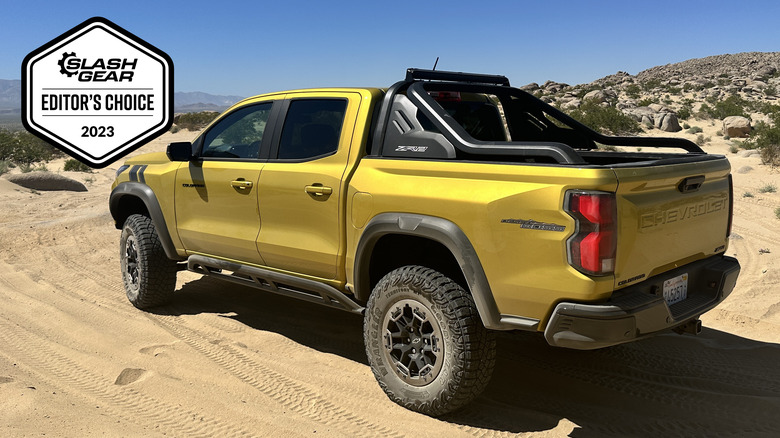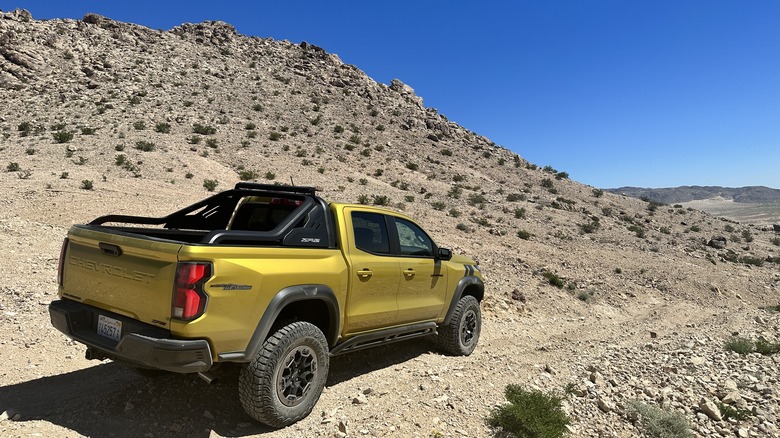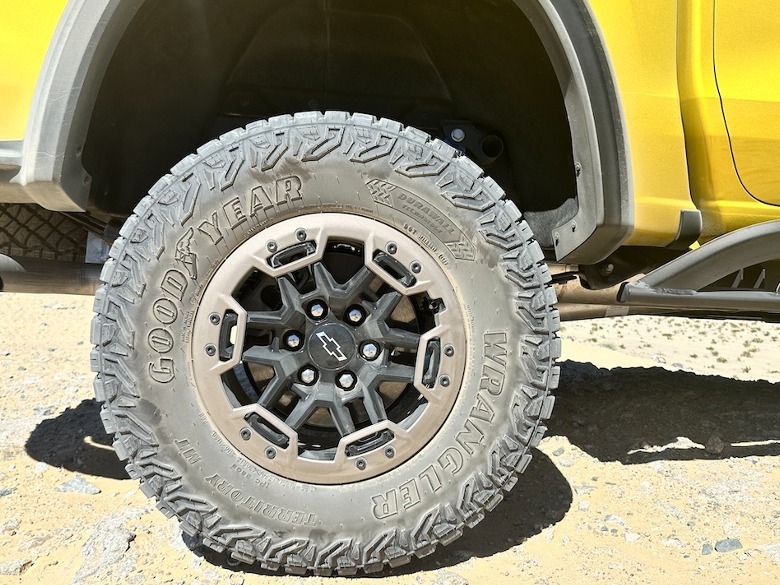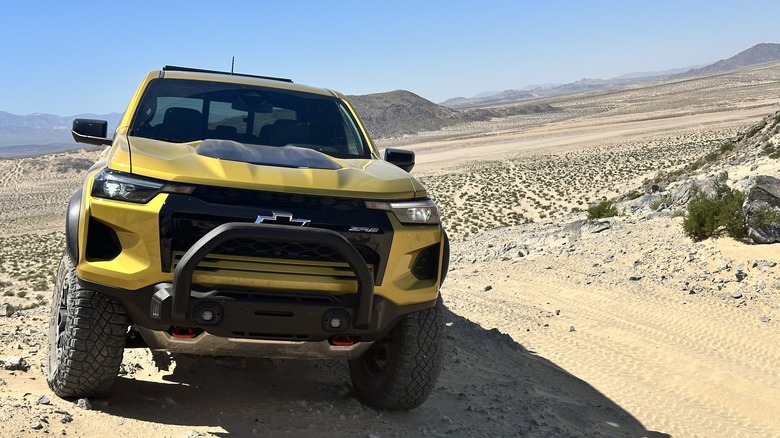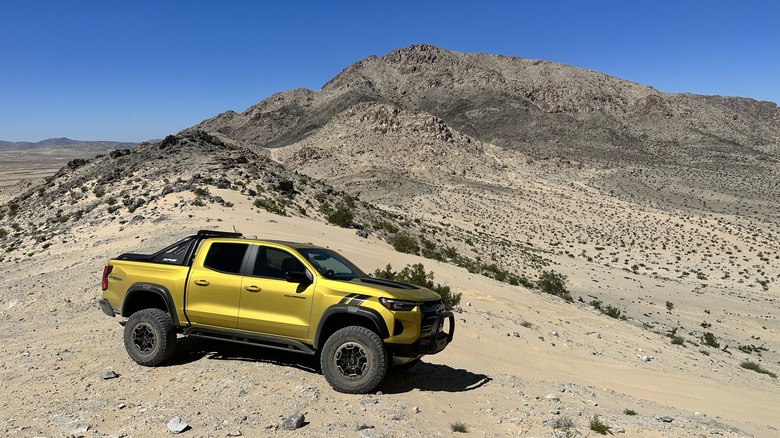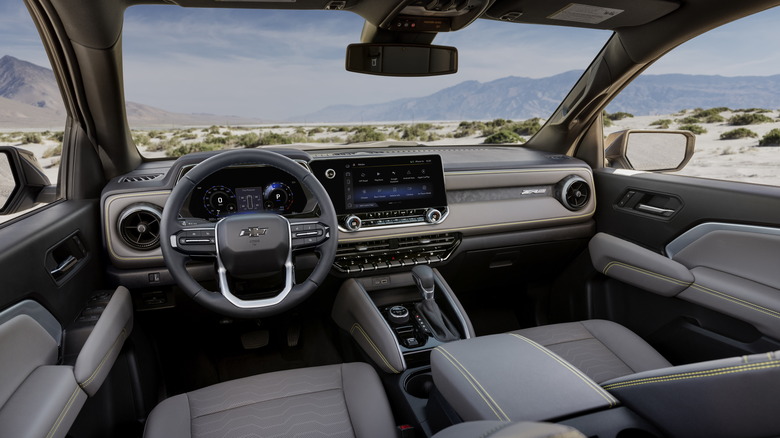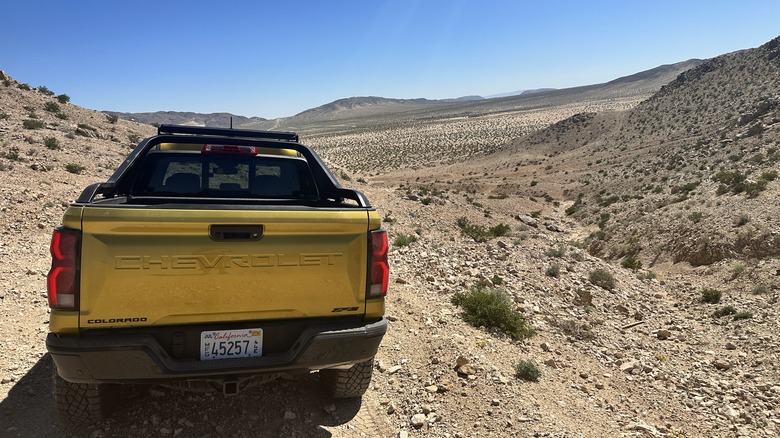2023 Chevrolet Colorado ZR2 Review: The Off-Road Truck We'd Buy
- Excellent suspension
- Strong motor
- Great infotainment
- Reduced towing and hauling capability
- Headlight control buried in infotainment
- Pricey Desert Boss package
Most basic trucks can be driven off-road. It might be uncomfortable, you'll likely not be able to go very fast and you'll probably get stuck, but the majority of trucks for sale today can handle some amount of dirt driving. But what if you want a rig that's actually good in the dirt? One that can hustle through some whoops, carve out a dune or two, and do it all in comfort? That's when you'll want the 2023 Chevrolet Colorado ZR2.
The mid-size Colorado is available in WT, LT, Z71 and Trail Boss trims, but today I'm talking about the tippy top ZR2 model. Only available as a crew cab with a standard bed and the high-output 2.7-liter turbocharged four-cylinder engine, my tester gets a special Desert Boss trim on top of its ZR2 goodness.
Standard kit for the ZR2 includes the excellent Multimatic DSSV dampers–more on those in bit–front and rear locking differentials, skid plates, upgraded control arms, redesigned front and rear bumpers for more clearance, a 3.42 rear axle, a three-inch lift and wider stance, rocker panel protection, and 17-inch wheels with 33-inch Goodyear Wrangler tires. On top of that, the Desert Boss adds a cool in-bed roll bar, a modified front bumper, auxiliary lighting on the roof, and an underbody camera.
Like a boss
My favorite feature by far are the Multimatic shocks. These dampers contain spool valves in place of shims, making them tunable for pretty much any application. Although there are five driving modes, none alter the stiffness of the shocks, because the spool valves do it for you. Hustle the ZR2 up a canyon road and you'll find little body roll, then cruise on over to some whoops and there is very little harshness. I wish I could have these shocks on my personal off-road vehicle.
That's not to say the drive modes don't set any parameters on the truck. Baja mode keeps the revs high and the throttle responsive, while Terrain mode is best for slow-speed rock crawling. Terrain mode will also enable one-pedal driving, so those who prefer not to left-foot brake in the rocks merely have to lift off the gas pedal to employ the brakes. Off-road mode is best for general dirt driving, while Tow/Haul and Normal modes, hopefully, are self-explanatory.
With its lift and off-road bumpers, the Colorado ZR2 sports some excellent geometry. You can count on nearly 11 inches of ground clearance, and approach, departure, and breakover angles of 38.3, 25.1, and 24.6 degrees respectively. For those keeping score, that keeps up with the mighty Jeep Gladiator in Willys and Mojave trims in all but approach angle.
Desert vibes
How does that all work in the dirt? Pretty darn good. The 2.7-liter turbocharged four-cylinder engine here pushes out a healthy 310 horsepower and 430 pound-feet of torque, and is mated to an eight-speed automatic transmission. Power delivery is smooth and shifts happen in the background. There is a bit of turbo lag here, but the rest of the truck is so good, I'm not even mad.
The ZR2 has been tested in various desert races like the Mint 400 and Vegas to Reno by Hall Racing (no relation) and has finished every single mile of them all. As someone who has broken her car during a race and had to withdraw on more than one occasion, I can tell you that a 100-percent finish rate is almost unheard of.
I took my Colorado tester out to Johnson Valley, California to scout possible race course for an upcoming event. Much of this area has already been raced on and it's rocky, whooped out, and rough as all get out. A few times I had to rely on the rocker protection as I navigated the boulder-strewn slopes, but the ZR2 handled it all. When I got in a pickle I just shifted to low gear. When that wasn't enough I switched on my rear locker for more traction going up a slippery slope. When I misjudged a line and got stuck in a bit of a hole, adding the front locker pulled me up and out easily.
Johnson Valley also has its share of soft sand. The power here allowed me to keep my momentum and I was able to traverse the hills without getting stuck. In larger dunes I'd want to air down my tires to help with floatation, but out here the truck does fine.
Utility compromises
Finally, I hit the whoops. This is where the truck's 10.0 inches of travel in the front and 11.6 in the rear combined with the Multimatics really shine. The ride wasn't jarring at all, and the shocks kept the truck from bucking on rebound. I could've probably gone a bit faster had I upgraded to the Colorado ZR2 Bison with its jounce bumpers, but even without them the ride quality across this section was great. When I got ahead of myself and fully compressed the shocks, there wasn't any clucking sound– or jarring motion– coming from the chassis. Like I said, I want this set-up for my own vehicle.
The only bummer here is towing and hauling capability. By putting a premium on off-road performance, the ZR2's utility takes a hit. A standard Colorado can tow up to 7,700 pounds and haul 1,684 pounds in the bed. However, my tester was only rated to handle 6,000 pounds of towing and 1,151 pounds of cargo. If you've got larger loads to tote around, you'll need to move up to the Silverado 1500 ZR2.
Hurrah for Google Maps
Inside the cabin is dominated by an 11.3-inch infotainment touchscreen with Google built-in. I'm glad Chevy has realized that it doesn't need to reinvent the navigational wheel: Just give us Google Maps and stop trying to develop your own in-dash nav system, thank you very much. What's cool here are the off-road pages with altitude, GPS coordinates, a compass with numerical headings, information on pitch and roll, and even a g-force and wheel-slip indicator for those high-speed Baja mode moments. I wish all off-road trucks got into the nitty gritty like this.
Chevrolet's infotainment system is intuitive and quick-loading but for some reason the screen is the only place a driver can access the headlight controls. The idea here is that people will just put the headlights in Auto and forget about them, but I like to have a bit more control. For instance, it's always best to turn on your lights when off-roading so other people can see you, and the desert highway near my house has a daytime headlight section. I shouldn't have to take my eyes off the road and mess around with a screen to be sure my lights are on.
The Chevy Safety Assist package is standard across the line and includes forward collision alert, lane keeping assist with warning, automatic emergency braking and front pedestrian braking, a following distance indicator, and automatic high-beams. And thank God for that last one. Can you imagine having to go into the infotainment system every time you wanted to turn on your brights?
2023 Chevrolet Colorado ZR2 Verdict
The 2023 Chevrolet Colorado ZR2 starts at right around $48,000 including $1,495 for destination. The Desert Boss package adds over $9,000 to the bottom line, which frankly isn't worth it. The lights are placed too far back on the roof to really illuminate the road and aftermarket bumpers can be found pretty cheap. The wheels are nice but $9,000 is a tough ask.
As for the competition, the upcoming Ford Ranger Raptor should be pretty capable and the 2024 Tacoma will be offered with a powerful hybrid powerplant, although neither of those trucks are for sale yet. However, the ZR2 is definitely a truck I would buy, albeit without the Desert Boss package. After driving it I am seriously considering putting a down payment on one, and that's not something I say lightly.
